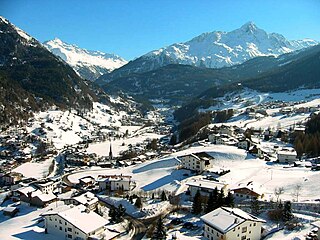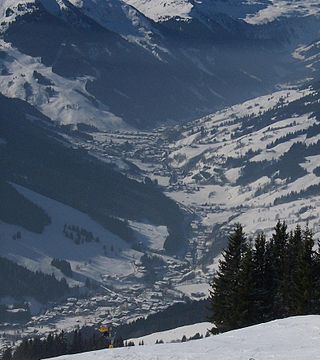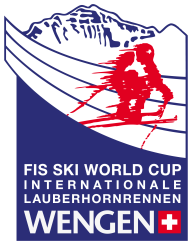
The FIS Alpine Ski World Cup is the top international circuit of alpine skiing competitions, launched in 1966 by a group of ski racing friends and experts which included French journalist Serge Lang and the alpine ski team directors from France and the USA. It was soon backed by International Ski Federation president Marc Hodler during the FIS Alpine World Ski Championships 1966 at Portillo, Chile, and became an official FIS event in the spring of 1967 after the FIS Congress at Beirut, Lebanon.

Schruns is a municipality in the Montafon valley, in the Bludenz district of the westernmost Austrian state of Vorarlberg.

Super giant slalom, or super-G, is a racing discipline of alpine skiing. Along with the faster downhill, it is regarded as a "speed" event, in contrast to the technical events giant slalom and slalom. It debuted as an official World Cup event during the 1983 season and was added to the official schedule of the World Championships in 1987 and the Winter Olympics in 1988.

Hermann Maier is an Austrian former World Cup champion alpine ski racer and Olympic gold medalist. Nicknamed the "Herminator", Maier ranks among the greatest alpine ski racers in history, with four overall World Cup titles, two Olympic gold medals, and three World Championship titles. His 54 World Cup race victories – 24 super-G, 15 downhills, 14 giant slaloms, and 1 combined – rank third on the men's all-time list behind Ingemar Stenmark's 86 victories and Marcel Hirscher's 67 victories. Until 2023 he held the record for the most points in one season by a male alpine skier, with 2000 points from the 2000 season. From 2000–2013 he also held the title of most points in one season by any alpine skier, until Tina Maze scored 2414 points in the 2013 season.

Wengen is a mountain village in the Bernese Oberland of central Switzerland. Located in the canton of Bern at an elevation of 1,274 m (4,180 ft) above sea level, it is part of the Jungfrauregion and has approximately 1,300 year-round residents, which swells to 5,000 during summer and to 10,000 in the winter. Wengen hosts the classic Lauberhorn ski races of the FIS Alpine Ski World Cup in January.

Lech am Arlberg is a mountain village and an exclusive ski resort in the Bludenz district in the westernmost Austrian state of Vorarlberg, on the banks of the river Lech.

Schladming is a small former mining town in the northwest of the Austrian state of Styria that is now a popular tourist destination. It has become a large winter-sports resort and has held various skiing competitions, including most notably the FIS Alpine World Ski Championships 1982 and the FIS Alpine World Ski Championships 2013. The shopping area has many cafes and restaurants, and a variety of shops that cater to tourists.

Sölden is a municipality in the Ötztal valley of Tyrol, Austria.

Saalbach-Hinterglemm is a municipality in the district of Zell am See, in the Austrian state of Salzburg. It is well known for its skiing and other winter sports. A four-piste network consisting of Saalbach, Hinterglemm, Fieberbrunn and Leogang is located in the municipality, adding up to 270 kilometres (170 mi) of ski slopes. It is short transfer to resort from Salzburg Airport.

Hannes Trinkl is an Austrian former alpine skier.

Semmering is a town in the district of Neunkirchen in the Austrian state of Lower Austria. It is noted for its skiing, and has hosted the Alpine skiing World Cup several times. When the Semmering Railway was completed in 1854, the town quickly became a popular tourist getaway in winter months. In 2011, the town had a permanent population of 571.

Flachau is a village in the district of St. Johann im Pongau in the Austrian state of Salzburg, with a population of 2,802. Its numerous skiing facilities are part of the Ski Amadé network of ski areas, one of the largest in Europe.

Birds of Prey is a World Cup downhill ski course in the western United States, located at Beaver Creek Resort in Avon, Colorado. The race course made its World Cup debut 27 years ago in December 1997.

Kristaps Zvejnieks is an Alpine ski racer and inline Alpine slalom racer from Latvia. He competed for Latvia at the 2010 Winter Olympics. He competed in slalom and giant slalom and his best result was a 37th place in the slalom. He competes in FIS, CIT, EC and WC levels. He had his first World Cup start in Schladming on 24 January 2012.

The Lauberhorn ski races (Lauberhorn World Cup alpine ski races are among the highest-attended winter sports events in the world, attracting around 30,000 spectators each year. An established attraction is the airshow by the Patrouille Suisse, the aerobatic demonstration team of the Swiss Air Force. The 2016 races were held 15–17 January.

The International Ski Federation (FIS) Alpine Ski World Cup, the premier circuit for alpine skiing competition, began in January 1967, and the 2019–20 season marked the 54th consecutive year for the FIS World Cup. As it had every year since 2006, the season began in Sölden, Austria in October. The season was supposed to end with the World Cup finals in March, which were to be held in Cortina d'Ampezzo, Italy for the first time since they began in 1993, but the finals were cancelled due to the COVID-19 outbreak in Italy.

The men's super-G in the 2020 FIS Alpine Skiing World Cup involved six events, as the last two scheduled Super-Gs were canceled.

The men's giant slalom in the 2020 FIS Alpine Skiing World Cup involved seven events, as the last two scheduled giant slaloms in the season were cancelled.

The Men's combined in the 2020 FIS Alpine Skiing World Cup involved 3 events, all of which were completed before the season was halted due to the COVID-19 pandemic. A major change was made in the discipline this season due to the recent dominance of slalom specialists in the combined over speed racers. As was previously the case, the first run continued to be the speed discipline. The second run then started in reverse order of finish in the speed run, which allowed the slalom specialists to tackle fresh snow as the first down the hill in the slalom run, while the speed specialists had to face the more challenging rutted snow at the end of the day, as the last skiers of the 30 who qualified for the second run. Instead, the second run was changed to start in the same order as the finish of the speed run, so that the leader after the speed run became the first to race on the fresh slalom course.

Rettenbach is a World Cup giant slalom ski course in Austria on Rettenbach glacier above Sölden, Tyrol. Located on Wildspitze mountain in the Ötztal Alps, the race course debuted in 1993.






















